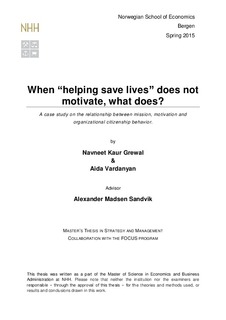When “helping save lives” does not motivate, what does? A case study on the relationship between mission, motivation and organizational citizenship behavior
Master thesis
Permanent lenke
http://hdl.handle.net/11250/300153Utgivelsesdato
2015Metadata
Vis full innførselSamlinger
Sammendrag
This research is conducted as a multiple case study in Laerdal Medical, a global mission-driven organization, whose mission is helping save lives. The thesis seeks to explore the relationship between a prosocial mission, prosocial motivation in employees and organizational citizenship behavior (OCB). Existing literature indicates that OCB is considered a beneficial factor and promotes the smooth functioning of organizations, but it is still difficult to identify exactly what stimulates OCB in organizations. Some researchers state that prosocial motivation is considered an important element for OCB within an organization, and that there is a relationship between a company mission and prosocial motivation. Based on the importance of OCB in organizations, this thesis seeks to supplement existing literature with more research on the relationship between an organization’s mission, prosocial motivation and occurrence of OCB. The results reveal that a mission might be prosocial, present and also effective, but that it does not seem to stimulate prosocial motivation within the employees by only those three qualities. So if helping save lives does not motivate, what does? The data indicates that prosocial motivation within employees is weak, but it still shows high level of OCB present. The findings further suggest that the occurrence of OCB is due to highly present intrinsic and extrinsic motivators within the employees. An additional trait, that was not initially expected, is the presence of job satisfaction, which particularly nurtures OCB.
